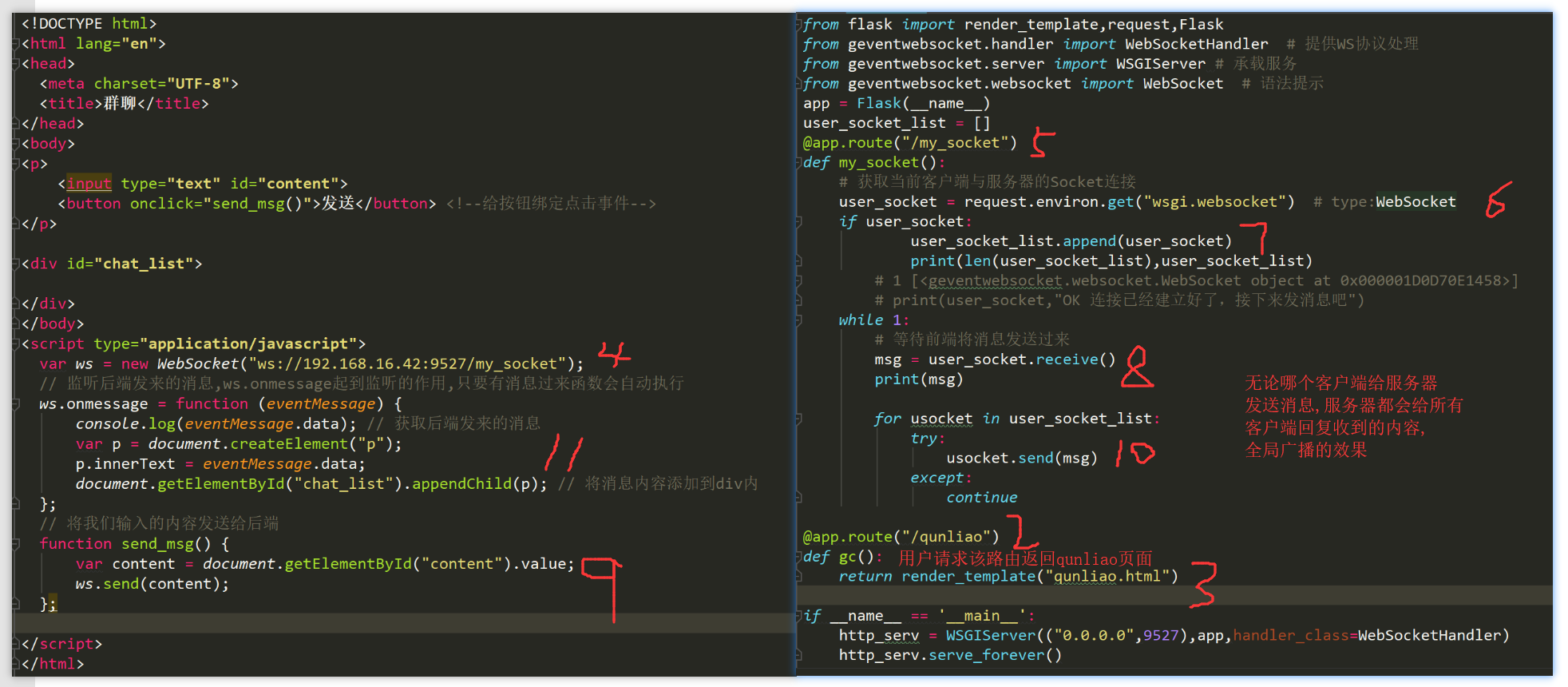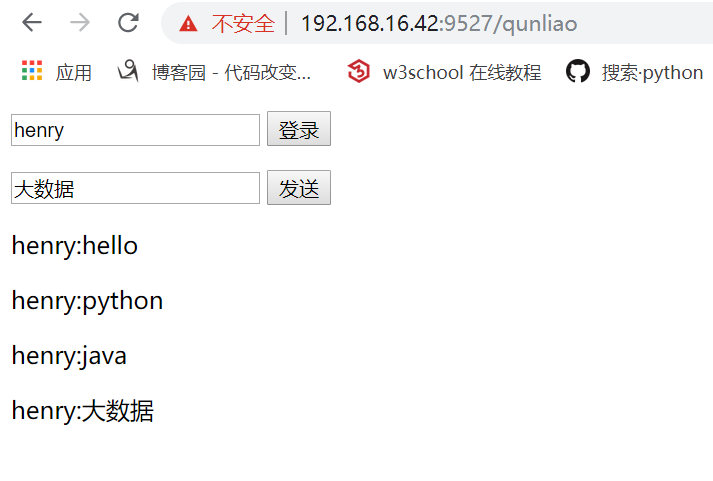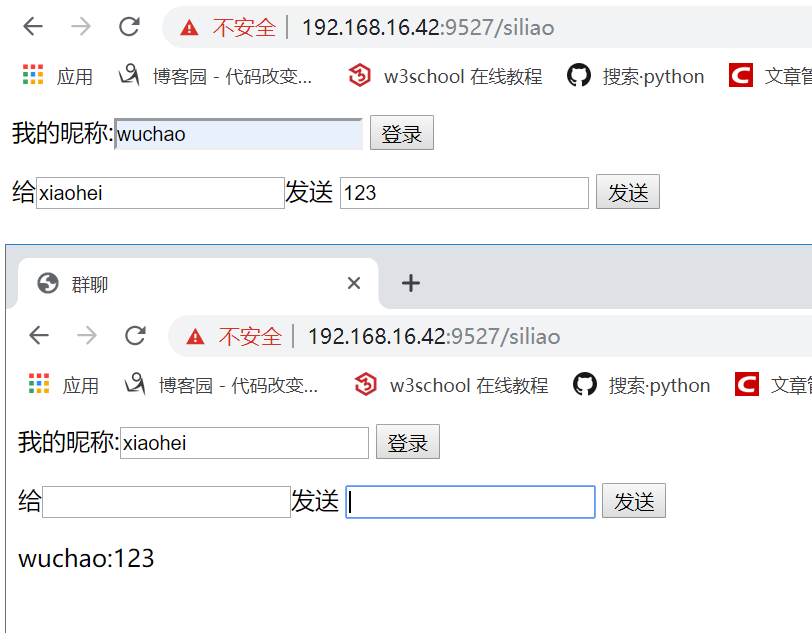群聊无昵称
原生js代码
<!DOCTYPE html> <html lang="en"> <head> <meta charset="UTF-8"> <title>群聊</title> </head> <body> <p> <input type="text" id="content"> <button onclick="send_msg()">发送</button> <!--给按钮绑定点击事件--> </p> <div id="chat_list"> </div> </body> <script type="application/javascript"> var ws = new WebSocket("ws://192.168.16.42:9527/my_socket"); // 监听后端发来的消息,ws.onmessage起到监听的作用,只要有消息过来函数会自动执行 ws.onmessage = function (eventMessage) { console.log(eventMessage.data); // 获取后端发来的消息 var p = document.createElement("p"); p.innerText = eventMessage.data; document.getElementById("chat_list").appendChild(p); // 将消息内容添加到div内 }; // 将我们输入的内容发送给后端 function send_msg() { var content = document.getElementById("content").value; ws.send(content); }; </script> </html>
后端逻辑代码
# -*- coding: utf-8 -*- # @Time : 2019/7/15 16:42 from flask import render_template,request,Flask from geventwebsocket.handler import WebSocketHandler # 提供WS协议处理 from geventwebsocket.server import WSGIServer # 承载服务 from geventwebsocket.websocket import WebSocket # 语法提示 app = Flask(__name__) user_socket_list = [] @app.route("/my_socket") def my_socket(): # 获取当前客户端与服务器的Socket连接 user_socket = request.environ.get("wsgi.websocket") # type:WebSocket if user_socket: user_socket_list.append(user_socket) print(len(user_socket_list),user_socket_list) # 1 [<geventwebsocket.websocket.WebSocket object at 0x000001D0D70E1458>] # print(user_socket,"OK 连接已经建立好了,接下来发消息吧") while 1: # 等待前端将消息发送过来 msg = user_socket.receive() print(msg) for usocket in user_socket_list: try: usocket.send(msg) except: continue @app.route("/qunliao") def gc(): return render_template("qunliao.html") if __name__ == '__main__': http_serv = WSGIServer(("0.0.0.0",9527),app,handler_class=WebSocketHandler) # 这种启动方式和app.run()不冲突,该启动方式发什么请求都可以接受到 http_serv.serve_forever()
流程
1、用户在网页请求http://192.168.16.42:9527/qunliao 2、请求/qunliao这个路由走后端对应的视图函数gc返回qunliao.html这个页面, 3、页面在加载的过程中走到script代码时建立WebSocket连接请求ws://192.168.16.42:9527/my_socket, 4、ws://192.168.16.42:9527/my_socket请求走后端对应的视图函数,获取当前客户端与服务器的socket连接对象,调用该对象的receive方法,等待前端发来消息, 5、前端我们通过给input框绑定点击事件,获取用户输入的内容发送给服务器; 6、后端将前端发来的消息在发送给前端; 7、前端通过ws.onmessage这个事件监听着后端过来的消息,只要有消息就会自动触发函数执行并获取数据;
第一步是浏览器向/quliao这个路径发起请求:

jQuery

<!DOCTYPE html> <html lang="en"> <head> <meta charset="UTF-8"> <title>群聊</title> </head> <body> <p> <input type="text" id="content"> <button id="send_msg" >发送</button> <!--给按钮绑定点击事件--> </p> <div id="chat_list"> </div> </body> <script src="/static/jquery-3.4.1.js"></script> <script type="application/javascript"> var ws = new WebSocket("ws://192.168.16.42:9527/my_socket"); // 监听后端发来的消息,ws.onmessage起到监听的作用,只要有消息过来函数会自动执行 ws.onmessage = function (eventMessage) { console.log(eventMessage.data); // 获取后端发来的消息 var p = document.createElement("p"); // 创建一个p标签 p.innerText = eventMessage.data; // 将后端发来的数据添加到p标签内 $("#chat_list").append(p) // 将p标签添加到div内 }; // 将我们输入的内容发送给后端 $("#send_msg").click(function () { var content = $("#content").val(); ws.send(content); }) </script> </html>

from flask import render_template,request,Flask from geventwebsocket.handler import WebSocketHandler # 提供WS协议处理 from geventwebsocket.server import WSGIServer # 承载服务 from geventwebsocket.websocket import WebSocket # 语法提示 app = Flask(__name__,static_folder="statics",static_url_path="/static") # 获取静态文件 user_socket_list = [] @app.route("/my_socket") def my_socket(): # 获取当前客户端与服务器的Socket连接 user_socket = request.environ.get("wsgi.websocket") # type:WebSocket if user_socket: user_socket_list.append(user_socket) print(len(user_socket_list),user_socket_list) # 1 [<geventwebsocket.websocket.WebSocket object at 0x000001D0D70E1458>] # print(user_socket,"OK 连接已经建立好了,接下来发消息吧") while 1: # 等待前端将消息发送过来 msg = user_socket.receive() print(msg) for usocket in user_socket_list: try: usocket.send(msg) except: continue @app.route("/qunliao") def gc(): return render_template("qunliao.html") if __name__ == '__main__': http_serv = WSGIServer(("0.0.0.0",9527),app,handler_class=WebSocketHandler) http_serv.serve_forever()
带群昵称的群聊
通过动态路由参数获取前端传过来的用户名

<!DOCTYPE html> <html lang="en"> <head> <meta charset="UTF-8"> <title>群聊</title> </head> <body> <input type="text" id="username"> <button id="login">登录</button> <p> <input type="text" id="content"> <button id="send_msg" >发送</button> <!--给按钮绑定点击事件--> </p> <div id="chat_list"> </div> </body> <script src="/static/jquery-3.4.1.js"></script> <script type="application/javascript"> var ws = null; // 创建全局变量,ws多处使用 $("#login").click(function () { var username = $("#username").val(); console.log(username); // 创建一个websocket对象,建立websocket连接,更改了全局的ws,将用户名拼接上 ws = new WebSocket("ws://192.168.16.42:9527/my_socket/" + username); // 监听后端发来的消息,ws.onmessage起到监听的作用,只要有消息过来函数会自动执行 ws.onmessage = function (eventMessage) { console.log(eventMessage.data); // 获取后端发来的消息 var str_obj = JSON.parse(eventMessage.data); // 反序列化,因为我们在发送给后端的时候是json var p = document.createElement("p"); // 创建一个p标签 $(p).text(str_obj.from_user +":"+str_obj.chat); // 将dom对象转换成jQuery对象,将后端发来的数据添加到p标签内 $("#chat_list").append(p) // 将p标签添加到div内 }; }); // 将我们输入的内容发送给后端 $("#send_msg").click(function () { var content = $("#content").val(); var username = $("#username").val(); // 将要发送的内容封装成自定义对象 var sendStr = { from_user:username, chat:content }; console.log(sendStr); // 序列化后发送给后端 ws.send(JSON.stringify(sendStr)); }); </script> </html>

from flask import render_template,request,Flask from geventwebsocket.handler import WebSocketHandler # 提供WS协议处理 from geventwebsocket.server import WSGIServer # 承载服务 from geventwebsocket.websocket import WebSocket # 语法提示 app = Flask(__name__,static_folder="statics",static_url_path="/static") user_socket_dict = {} # 建立websocket连接时,前端将名字发送过来了 @app.route("/my_socket/<username>") def my_socket(username): # 获取当前客户端与服务器的Socket连接 user_socket = request.environ.get("wsgi.websocket") # type:WebSocket if user_socket: # 以名字为key,连接对象为value添加到字典中 user_socket_dict[username] = user_socket while 1: # 等待前端将消息发送过来,此时是json数据 msg = user_socket.receive() for usocket in user_socket_dict.values(): try: # 将收到的信息在发送给所有与服务器建立连接的前端 usocket.send(msg) except: continue @app.route("/qunliao") def gc(): return render_template("qunliaonicheng.html") if __name__ == '__main__': http_serv = WSGIServer(("0.0.0.0",9527),app,handler_class=WebSocketHandler) http_serv.serve_forever()
效果:

websocket实现私聊

<!DOCTYPE html> <html lang="en"> <head> <meta charset="UTF-8"> <title>群聊</title> </head> <body> 我的昵称:<input type="text" id="username"> <button id="login">登录</button> <p> 给<input type="text" id="to_user">发送 <input type="text" id="content"> <button id="send_msg" >发送</button> <!--给按钮绑定点击事件--> </p> <div id="chat_list"> </div> </body> <script src="/static/jquery-3.4.1.js"></script> <script type="application/javascript"> var ws = null; // 创建全局变量,ws多处使用 $("#login").click(function () { var username = $("#username").val(); console.log(username); // 创建一个websocket对象,建立websocket连接,更改了全局的ws,将用户名拼接上 ws = new WebSocket("ws://192.168.16.42:9527/my_socket/" + username); // 监听后端发来的消息,ws.onmessage起到监听的作用,只要有消息过来函数会自动执行 ws.onmessage = function (eventMessage) { console.log(eventMessage.data); // 获取后端发来的消息 var str_obj = JSON.parse(eventMessage.data); // 反序列化,因为我们在发送给后端的时候是json var p = document.createElement("p"); // 创建一个p标签 $(p).text(str_obj.from_user +":"+str_obj.chat); // 将dom对象转换成jQuery对象,将后端发来的数据添加到p标签内 $("#chat_list").append(p) // 将p标签添加到div内 }; }); // 将我们输入的内容发送给后端 $("#send_msg").click(function () { var content = $("#content").val(); var username = $("#username").val(); var to_user = $("#to_user").val(); // 将要发送的内容封装成自定义对象 var sendStr = { from_user:username, chat:content, to_user:to_user, }; console.log(sendStr); // 序列化后发送给后端 ws.send(JSON.stringify(sendStr)); }); </script> </html>

import json from flask import render_template,request,Flask from geventwebsocket.handler import WebSocketHandler # 提供WS协议处理 from geventwebsocket.server import WSGIServer # 承载服务 from geventwebsocket.websocket import WebSocket # 语法提示 app = Flask(__name__,static_folder="statics",static_url_path="/static") user_socket_dict = {} # 建立websocket连接时,前端将名字发送过来了 @app.route("/my_socket/<username>") def my_socket(username): # 获取当前客户端与服务器的Socket连接 user_socket = request.environ.get("wsgi.websocket") # type:WebSocket if user_socket: # 以名字为key,连接对象为value添加到字典中 user_socket_dict[username] = user_socket while 1: # 等待前端将消息发送过来,此时是json数据 msg = user_socket.receive() print(msg) # {"from_user":"wuchao","chat":"123","to_user":"xiaohei"} # 反序列化 msg_dict = json.loads(msg) # 查找字典中前端要发送信息给那个人的名字 to_username = msg_dict.get("to_user") # 获取目标人物的连接地址 to_user_socket = user_socket_dict.get(to_username) # 将信息发送给目标人物 to_user_socket.send(msg) @app.route("/siliao") def gc(): return render_template("siliao.html") if __name__ == '__main__': http_serv = WSGIServer(("0.0.0.0",9527),app,handler_class=WebSocketHandler) http_serv.serve_forever()
效果

